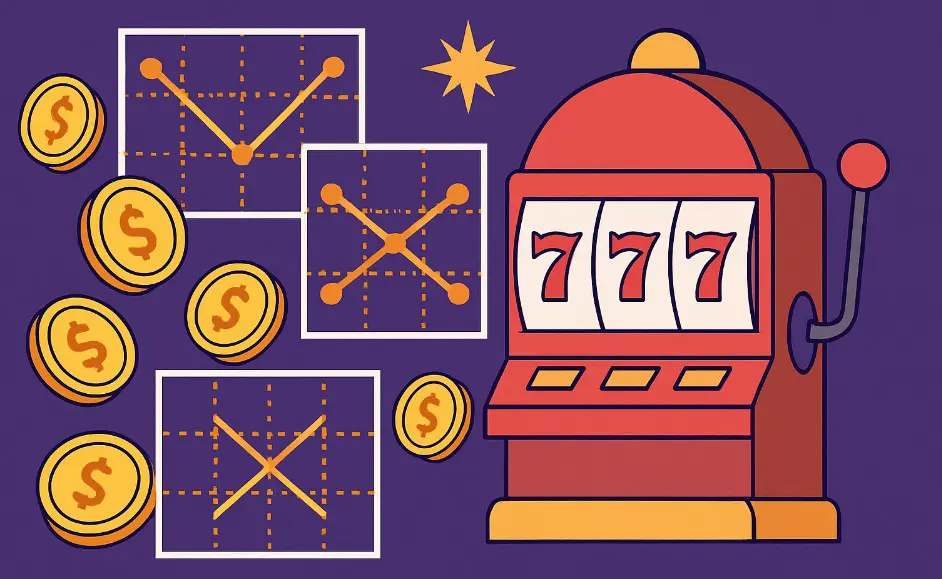Slot machines aren’t what they used to be. Once upon a time, you’d yank a lever, hope for three matching cherries in a row, and that was it. Now, things have gotten far more layered—and, let’s be honest, a lot more fun. The big game-changer? Multi-payline slots. They give you more ways to win, keep the action moving, and let you feel like you’re always “in the mix,” even when the reels don’t line up exactly the way you want. Let’s wander through how they work, why they matter, and a few things I’ve learned (sometimes the hard way) along the way.
What Are Multi-Payline Slots?
Definition and Mechanics
A multi-payline slot is basically a machine that doesn’t lock you into just one winning line across the middle. Instead, it offers multiple pathways—think diagonals, zigzags, or even funky “V” shapes—where symbols can land and pay out. The random number generator (RNG) decides where everything lands, and if enough of the right symbols line up on any of those lines you’ve activated, you’re in for a win.
I remember the first time I played a 25-line slot; I thought I’d broken the machine because it kept dinging and flashing even though I didn’t see a straight line of anything. Turned out I’d won on three different zigzagging paylines at once. Not life-changing money, but I did buy myself lunch with it.
Evolution from Single-Line Slots
Back in the day, you had one line. That was it. Three reels, one line, and usually one grumpy old machine that ate your coins faster than you could say “jackpot.” The odds of hitting anything decent were slim, and a losing streak felt brutal because spin after spin looked empty.
When video slots rolled in, developers had more room to play with. Suddenly you had 20, 30, even 100 paylines. It was like going from a black-and-white TV to full-on IMAX. More ways to win, more reasons to keep spinning, and definitely more reasons to feel like your next hit was just around the corner.
How Multi-Payline Slots Work
Understanding Payline Configurations
Paylines aren’t as simple as horizontal rows anymore. They crisscross the reels in patterns that can look like spaghetti if you stare too long at the paytable. Some go left to right, some right to left, and a few snake across the screen like they’re playing hopscotch.
When you’ve got 20 or more paylines active, it’s not unusual for one spin to pay out on two or three lines at once—even if the screen doesn’t look “obviously” lucky. That’s part of the fun: sometimes a small win sneaks up on you when you least expect it.
Activating and Betting on Paylines
Here’s where strategy and wallet meet. Some slots let you choose how many paylines to activate. Sure, you can save money by sticking to just a handful, but nothing hurts quite like watching five jackpot symbols line up perfectly on a payline you didn’t pay for. I’ve seen it happen, and the player next to me looked like he’d just lost his bus ticket home.
So, yes, more paylines cost more per spin, but they also cover your bases. It’s the classic trade-off: fewer spins with bigger risks, or more spins with a chance to hit something—anything—that keeps the session alive.
Payline Patterns and Payouts
The paytable is your friend here. Every line, every symbol, every multiplier—it’s all mapped out in there. And don’t forget the scatter symbols. They’re like the rebels of the slot world, paying out or unlocking features no matter where they land. Once, during a late-night session, I had three scatters land in the oddest places: top left, bottom right, and smack in the middle. Didn’t think it would count, but boom—free spins. That’s the beauty of multi-line slots: surprises are baked into the design.
Why Multi-Payline Slots Boost Winning Chances
More Combinations, More Wins
The math is simple. More active paylines mean more chances for something to land. Even if each line’s odds don’t change, the net effect is that your screen feels busier—and your bankroll lasts longer when small wins keep topping it back up.
Think of it like buying more raffle tickets. Each one alone won’t change the odds much, but a handful together makes you feel like you’ve got a shot at hearing your name called.
Volatility and RTP Explained
Here’s where people get tripped up. Multi-payline slots don’t magically raise the RTP. A machine with a 96% return to player still pays out the same overall percentage, whether you play one line or all fifty. What changes is volatility.
Low-volatility multi-line slots tend to drip-feed you small wins that keep the excitement ticking. High-volatility games, on the other hand, can feel like a drought until—bam—you hit a monster payout that makes you forget the last twenty empty spins. I once sat through what felt like half an hour of nothing on a high-volatility game, only to hit a bonus round that quadrupled my session bankroll. Patience paid off, but my nerves were fried.
Bonus Features and Additional Rewards
Multi-payline slots often bring extra fun to the table: bonus rounds, free spins, cascading reels. And sometimes those features come out of nowhere. Scatter symbols are notorious for this. You could have what looks like a dud spin, and suddenly the game drops you into a mini-game or free-spin frenzy.
It’s those moments—when you thought you were done—that keep players coming back. It’s almost like the slot knows how to reel you back in right when you’re about to give up.
Multi-Payline Slot Strategies

Managing Bet Size and Risk
Bankroll management is everything. I once burned through $50 in ten minutes because I forgot I had every payline maxed at $0.10 each. Rookie mistake. The smarter play? Keep your line bets small enough that you can afford to cover all the lines while stretching your money across dozens of spins.
You want to be around when the bonus finally triggers—not broke and heading for the exit.
Maximizing Winning Potential
If you ask regulars, they’ll tell you: always cover all the lines. Even if you’re betting tiny amounts, having every payline active means you won’t miss out when that magical combo finally appears. Nothing stings more than realizing the jackpot would’ve been yours… if only you’d paid for that line.
Responsible Bankroll Management
Multi-payline slots can trick you into thinking you’re winning more than you are. Those small wins keep you spinning, but they don’t always offset the total bet. It’s like eating chips—you don’t notice the bag disappearing until it’s empty.
Set a limit before you start, and be honest with yourself about walking away. I like to set two markers: a loss limit and a win goal. If I double my money, I cash out half. If I hit my loss limit, I stop. That way, I leave with at least some pride intact.
Popular Multi-Payline Slots to Try
Some slots have become almost legendary in this category. Cleopatra still pulls players in with its classic Egyptian theme and generous 20-line layout. Starburst is a crowd-pleaser online—simple, colorful, and surprisingly generous for a game with just 10 lines. And then you’ve got titles like Thunderstruck II, which mixes 243 ways to win with a thunderous soundtrack that’ll have you tapping your foot between spins.
If you want something that shows off just how wild payline structures can get, games like Book of Ra Deluxe or even newer “megaways” slots will keep you guessing.
Frequently Asked Questions About Multi-Payline Slots
Do more paylines really give me better odds?
They give you more chances per spin, yes. But the RTP stays the same overall. Think of it as spreading your luck across more doors to knock on.
Should I play fewer paylines but bet bigger on them?
Not usually. Covering all lines at lower bets feels safer and less frustrating. Missing a jackpot on a line you didn’t activate is a gut punch.
What’s the difference between paylines and ways to win?
Paylines are fixed routes. Ways-to-win systems (like 243-ways slots) pay out whenever symbols land on adjacent reels, no matter where they sit.
Can I still win big without paylines?
Sure. Scatters and bonus features don’t care about paylines. They pop up wherever and can unlock free spins, jackpots, or multipliers.
Are multi-payline slots good for beginners?
Absolutely. The steady trickle of small wins makes them less intimidating, and you’ll quickly learn how different line patterns work. Just keep your bets small until you’re comfortable.


